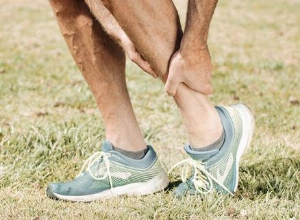Should You Be Worried About Bruising Easily?
Published 5 Jul 2016

It's happened to the best of us: You wake up with a small bruise on your leg or arm, and no matter how hard you try to remember what caused it, the source remains a mystery. For some people, it's simply a result of clumsiness. For others, these marks appear more frequently – seemingly out of nowhere – and last longer because they tend to bruise more easily.
A bruise is basically a form of internal bleeding. Usually, it's from some sort of trauma that causes blood vessels, or capillaries, under your skin to tear. Blood from these vessels leaks into the surrounding tissues and clots, first turning the injured area red and then dark blue. Before a bruise completely heals, its color will continue to change from blue to yellow to brown as the body sends macrophages, a kind of white blood cell, to break down red blood cells and clear away the clot.
"It's pretty rare to have spontaneous bruising," says Dr. Dana Neutze, a family physician at the University of North Carolina–Chapel Hill. "Sometimes the trauma is so minor you don't think of it as trauma." If you happen to bruise easily, it can take as little as a light bump into a table to cause a mark.
In rare instances, a bruise can be your body's way of telling you that something's wrong. Bruising is one of the most common symptoms that patients bring to their primary care physician, says Dr. Roy Silverstein, chairman of medicine at the Medical College of Wisconsin, Division of Hematology and Oncology and spokesperson for the American Society of Hematology. Often, though, easy bruising is not a cause for concern. It may just be the way your particular body was built, for example, or a normal sign of getting older.
Here are seven things to know about bruising:
It comes with aging. Bruising from minor trauma is common among older adults. As we age, our capillaries weaken and, therefore, break more easily. Our skin also becomes less elastic and thinner as we begin to lose that layer of fat underneath. "If you have more fat under the skin or more elastic tissue, that's going to cushion the area better," Neutze says. "And it's also going to prevent more blood from leaking out because there's just not the space for the blood to seep into."
Your habits are making your skin fragile. Excessive sun exposure can also weaken your skin, Silverstein says. In a 2012 study, researchers exposed pieces of stratum corneum – the skin's top layer – to ultraviolet rays equivalent to 12, 24 and 60 consecutive days of sunlight. They found that skin exposed to UV light is more likely to crack and chap, and they estimated that it only takes two days of sunlight to physically weaken skin tissues – so don't skimp on the sunscreen. Silverstein adds that smoking and steroid use are two other habits to avoid, as they could contribute to skin fragility.
It may be a sign of poor nutrition. Two vitamins are particularly important for bruises to heal, Neutze says: vitamin C helps with tissue repair, and vitamin K plays a major role in blood clotting. Both are found in fruits and leafy green vegetables, so excessive bruising may be your body's way of telling you that you need a more nutrient-rich diet. Silverstein points out that deficiency of these vitamins is actually very rare in the U.S. Still, he stresses the importance of maintaining a well-balanced diet that provides you with all the vitamins you need.
It could be affected by your medication. Having thinner blood or a low platelet count can both make you more susceptible to bruising and hinder your body's ability to stop bleeding, which makes it harder for bruises to heal. Older adults tend to be on more medication, some of which could cause blood thinning. "That's not to say you should stop the medication ever without speaking to the providers," Neutze says. But it might be worth asking your doctors about the medicine you take if you notice more bleeding or bruising than normal.
Easy bruising is written in your genes. "Some people just naturally have a tendency for bruising, but it's not harmful," Neutze says. They may have more fragile blood vessels or fairer skin, which makes bruises more apparent. In rare cases, the culprit is an underlying bleeding disorder that makes it difficult for blood to clot. The most common hereditary condition is von Willebrand disease, in which the patient has low levels of a specific protein that helps blood coagulate. Still, it's estimated to affect only one out of every 100 people in the U.S. The vast majority of those people, Neutze adds, experience no real symptoms or problems that require medical attention.
There are telltale signs of abnormal bruising. For the most part, bruising easily shouldn't ring any alarms. But abnormal bruising could indicate a disease like leukemia or an infection like sepsis – but Silverstein stresses that these cases are rare. "When bruising is abnormal, we look for size, location and how many bruises there are," he says. "So if there are a lot of bruises or if they're on sites that don't normally get banged around – like your lower back – or when there are bruises or blood blisters inside the mouth, that's when we really start to get worried."
Kids get bruises, too, and it's not always cause for concern. Before assuming the worst, keep in mind that children are active. "Kids bruising on the shins below the knees from trauma is very common, and it's hard to find a kid who hasn't had some kind of bruise some time or another," says Dr. Bertil Glader, a pediatrics professor specializing in hematology at the Stanford University School of Medicine. The challenge, like in adults, is to know when the bruising is above normal, which could suggest an underlying blood disorder involving low platelet count. Neutze suggests looking into your family history for prevalence of bleeding or bruising problems and asking your child's teachers if they've noticed him or her bumping into things a lot.
Health Care
4 comments



You will also like
Read the article

 Facebook
Facebook Twitter
Twitter



